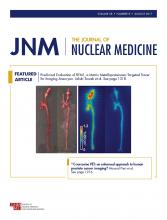See the associated article on page 1264.
In children, brain stem gliomas can have heterogeneous behavior, but most of these tumors are diffuse intrinsic pontine gliomas (DIPGs), which carry a poor prognosis with a median overall survival of only 11 mo (1). One of the biggest challenges to developing effective treatments has been the lack of tissue for analysis because the location of the tumor within the brain stem is difficult to access surgically. Recent studies using biopsy or autopsy specimens are changing this landscape and shedding light on distinct genetic changes in brain stem gliomas, such as mutations in genes encoding histones (2). As a result, the 2016 revised World Health Organization classification of brain tumors includes an entity for H3K27M-mutant diffuse midline glioma (3). What is important, however, is that many DIPGs are not biopsied—given the surgical risk—and the diagnosis is still made radiographically. Thus, imaging remains critical in the diagnosis of DIPG and in the assessment of treatment response.
DIPGs have a typical appearance on MRI, with expansion of the pons on fluid-attenuated inversion recovery/T2-weighted sequences. Contrast enhancement can be variable, however, and therefore does not always predict behavior. MR spectroscopy to measure ratios of choline to N-acetylaspartate has been proposed as a useful tool, with higher ratios being associated with worse survival (4,5). Elevated cerebral blood volume has also been associated with worse outcome (4).
A study by Zukotynski et al. in this issue of The Journal of Nuclear Medicine (6) looked at the baseline MRI and PET scans of 33 pediatric DIPG patients. The patients had been pooled from 4 clinical trials run through the Pediatric Brain Tumor Consortium designed to test the efficacy of radiation in conjunction with a molecularly targeted therapy. Pooling of the data was possible because, unfortunately, none of the trials showed efficacy and they therefore had similar progression-free survival and overall survival. The authors correlated apparent diffusion coefficient (ADC) values from MRI (a measure of tissue cellularity) and 18F-FDG uptake from PET with progression-free and overall survival. Specifically, they calculated histogram parameters (peak number, skewness, and kurtosis) for ADC and PET images within the contrast-enhancing tumor as well as the area of fluid-attenuated inversion recovery abnormality.
There was no association between the PET histogram parameters and progression-free or overall survival, whereas higher ADC skewness in the contrast-enhanced volume was associated with shorter progression-free survival. None of the other MRI histogram parameters reached statistical significance, although there were some trends that could be further explored. Intriguingly, there was a negative correlation between PET values and ADC values, with a higher level of negative correlation suggesting a shorter time to progression. These data may suggest that these imaging features reflect more aggressive tumors that can be identified early and selected for more aggressive therapy. Thus, the authors were able to identify potential noninvasive biomarkers of tumor behavior. The small sample size, although impressive for pediatric populations, does limit firm conclusions, and further validation of these results is necessary.
The particular strength of this work lies in the patient population, for which efforts to identify better imaging markers of DIPG are critical because surgery is not always feasible and certainly is not feasible when it needs to be repeated during treatment to assess response. Although the study by Zukotynski et al. looked only at pretreatment imaging, there is clearly an opportunity to extend this work to longitudinal monitoring. Because MRI is already a routine part of the care of DIPG patients, adding measures of ADC to response assessment algorithms would be relatively straightforward. Longitudinal PET imaging raises concerns about radiation exposure, but in a patient population already receiving high doses of radiation, a limited number of PET scans is unlikely to shift the risk–benefit balance significantly. Moreover, the number of new PET tracers that are more targeted to particular therapies or tumor biology is ever increasing. For example, 89Zr-labeled bevacizumab was recently evaluated in 7 DIPG patients to better understand tumor response to bevacizumab (7). These newer tracers, when combined with physiologic MRI measurements, hold great promise that we will be able to move beyond anatomic imaging to the study of tumor biology—a vital step in developing better drugs for this challenging disease.
DISCLOSURE
No potential conflict of interest relevant to this article was reported.
Footnotes
Published online Apr. 6, 2017.
- © 2017 by the Society of Nuclear Medicine and Molecular Imaging.
REFERENCES
- Received for publication March 9, 2017.
- Accepted for publication April 1, 2017.







